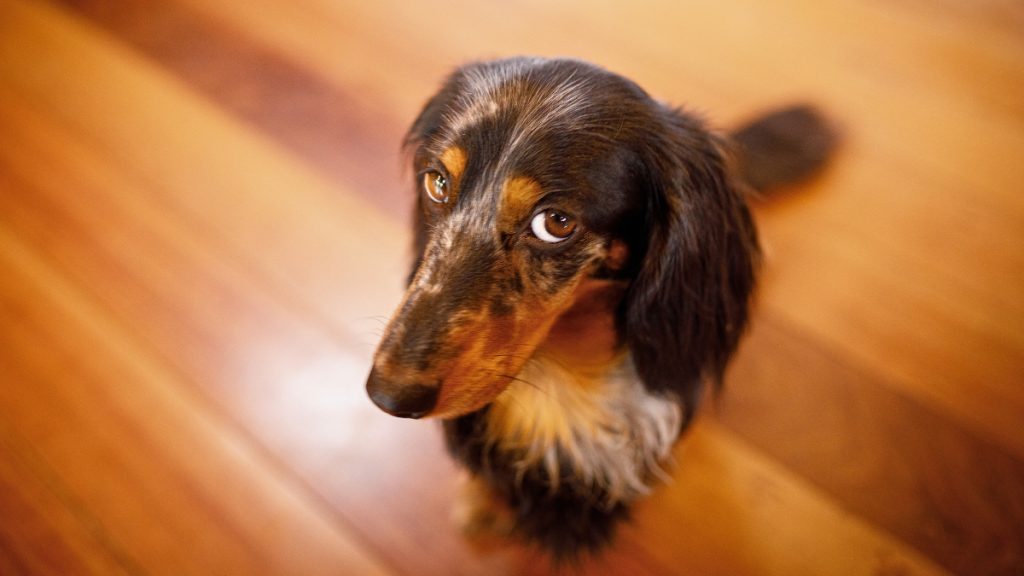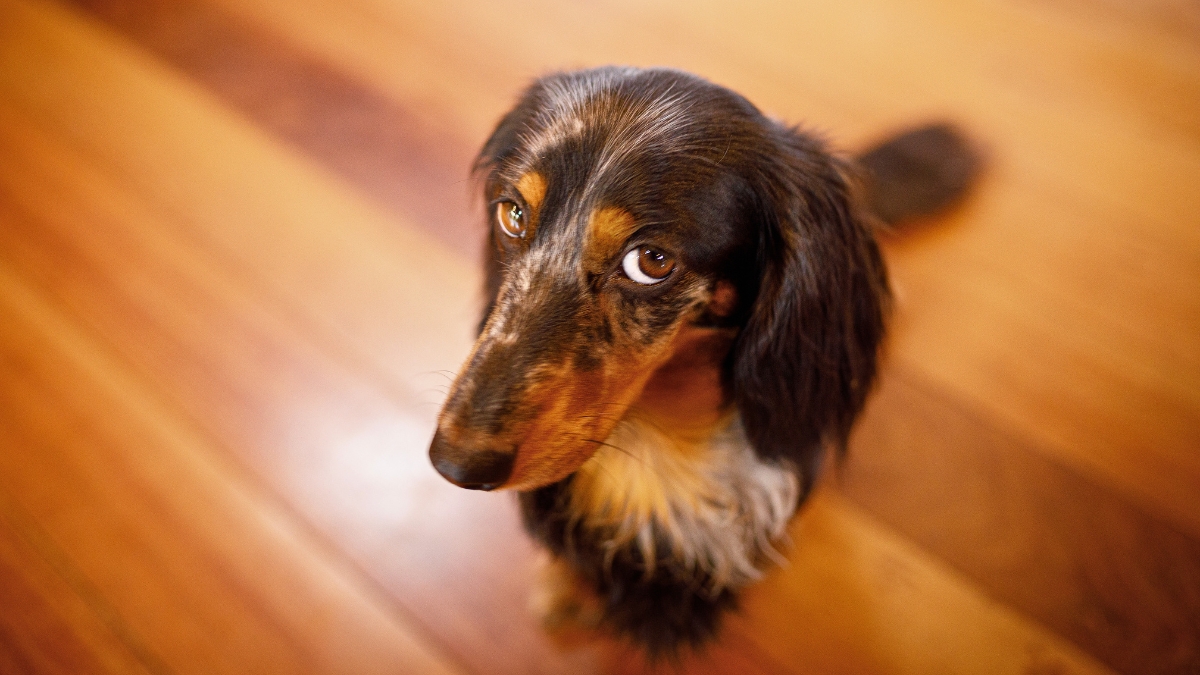You’ve probably seen your dog act like they know they’ve done something wrong. Maybe you came home to find a destroyed slipper or trash scattered across the floor. And when you look at your dog, you see they’re avoiding eye contact or look sad.
It’s at these times we often wonder: Does my dog feel guilty? Are they trying to apologize?
In this article, I want to explain how dogs show remorse and what signs you should look for to truly understand their emotions and behaviors.
Do Dogs Know When They’ve Done Something Wrong?
Although it might seem like they understand when they’ve misbehaved, dogs aren’t born knowing what’s right and wrong in our human world. For them, chewing on a cushion or digging in the yard is completely natural and even fun.
When you come home and your dog approaches you with their tail between their legs or ears back, they’re not expressing guilt but have learned to anticipate your reaction based on previous experiences.
Dogs are experts at reading our reactions and know that certain behaviors provoke certain responses from us.
If you always react similarly when you find a mess, your dog learns to associate that mess with your displeasure. If you scold your dog every time they do something you dislike, they learn to associate those moments with your anger.
It’s important to understand that they don’t feel guilty, but they learn to anticipate your reaction based on their past experiences.
Moreover, if you don’t correct your dog at the exact moment they do something wrong, they probably won’t understand why they’re being scolded.
If your dog is chewing a chair and you call their attention right then, they might connect the action with your disapproval. But if you scold them hours later, it will be hard for them to understand what they did wrong.
Therefore, what we perceive as guilt or remorse is really just a response to your emotions. But even though dogs may not fully understand what it means to feel remorseful, they do recognize when you’re upset or angry with them.
In those moments, they may try to reconnect with you to ensure you’re still happy and avoid any conflict.
How Do Dogs Apologize?
Even though we’ve seen that dogs don’t understand the concept of remorse as we do, they certainly have clear ways of expressing that they want to calm the situation and keep the peace.
Here I’ll explain what signs you should look for to interpret their behavior as an apology:
- Head and ears down: This posture shows submission and is a clear sign that your dog is trying to appease the situation.
- Sideways glance: Avoiding direct eye contact can be a way to reduce confrontation.
- Yawning: While it might seem like a sign of tiredness, in this context, it’s a signal of stress.
- Lip licking: The lips of dogs, when licked, indicate anxiety and an attempt to calm themselves.
- Tail between the hind legs, usually moving quickly: Indicates nervousness and an attempt to calm your spirits.
- Lying on the ground belly-up: Shows vulnerability and submission, trying to soothe your negative feelings.
- Approaching and moving away repeatedly: This action shows indecision and the desire to interact with you without causing further upset.
- Licking you: They might also lick you as a gesture of affection and submission.
- Bringing you a toy or seeking affection: Dogs might bring their favorite toy or seek petting as a way of finding some comfort.
All these behaviors are appeasement techniques your dog uses to reduce tension and ensure everything returns to normal.
Additionally, it’s important to remember that although your dog may not understand exactly what they did wrong, they can detect changes in your mood through your tone of voice, body language, and even your smell when you’re angry.
If your dog seems to be apologizing, it’s a sign they feel the stress of the situation and want to make things right with you.
Be sure not to prolong your anger as this can be very stressful for them, and whatever they did wrong, it wasn’t out of malice.

Do Dogs Apologize To Each Other?
Observing how dogs handle conflicts can be quite surprising. Unlike us, dogs don’t have conversations to resolve their differences, but they do have clear and effective ways to make peace. This is vital for them since they are social animals. This means they tend to avoid conflicts and, when they do occur, look for ways to reconcile.
I’ll tell you how dogs go from having a fight to being on good terms again. In a study at a dog park, researchers observed how dogs interacted after a conflict. And they discovered that these were the ways dogs try to restore peace and minimize stress:
- Licking each other: This behavior helps calm and comfort the other dog, showing friendship and willingness to remain sociable.
- Staying close to each other: By staying close, dogs show that they want to maintain the relationship and bear no grudge.
- Exhibiting submissive postures, like lying on their back: A dog showing its belly expresses submission and is not threatening, trying to appease its companion.
Researchers found that these behaviors not only restore relationships but also reduce future stress. Often, after a fight, both victims and aggressors spent more time together.
This shows that in dogs, forgiving seems to be more about moving past the incident than truly understanding why the conflict occurred.
This finding is crucial because it shows that although dogs don’t apologize with words like we do, they have mechanisms to ensure that group life remains harmonious.
Should You Forgive Your Dog When They Do Something Wrong?
This is important: you should always forgive your dog. Whether they’ve torn up a cushion, bitten furniture, or urinated inside the home, it makes no sense to hold a grudge for behavior that is natural for them and often a sign of stress or a need for attention.
Consider this: dogs chew for many reasons that are instinctive and necessary for them. Chewing can be a way to release pent-up energy and stay calm. In the wild, chewing is essential for the survival and health of dogs.
So, when your dog chooses something inappropriate to chew, it’s not out of malice but rather following a natural impulse. When your dog seeks your forgiveness through signs like approaching timidly or showing you affection, it’s important that you respond positively.
Use a kind tone of voice and offer comfort with petting, showing them that you’re not angry and that the incident is forgotten. This not only teaches them what behaviors are acceptable but also strengthens your bond with them.
Dogs act based on their instincts and needs, not to annoy you. Attributing human intentions like vengeance can lead to misunderstandings and unfair treatment. You must understand that they are simply dogs with needs and behaviors different from ours.

In conclusion, understanding your dog’s behavior is crucial for a harmonious relationship. Recognizing that their actions stem from natural instincts rather than malice allows you to respond with patience and understanding.
Always forgive your dog, as holding onto anger only creates stress for both of you. By showing compassion and guiding your dog with positive reinforcement, you build a stronger bond and ensure a peaceful coexistence.
Bibliography:
